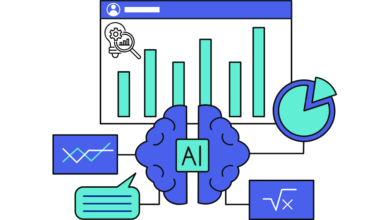
In recent months, the AI hype train has gathered huge momentum as real-world applications bring new and exciting possibilities to the market. While it’s widely acknowledged that the process of AI-led transformation has only just begun, there is already a range of commonly-held myths that are muddying the waters, causing organisations and employees to worry about the future. But what are the biggest AI misconceptions, and how can organisations work around them to ensure they get the most from the growing range of emerging technologies and applications?
1. Myth: Everyone knows everything about AI and has adopted the tech in their business
Reality: The assumption that AI is generally well-understood and widely adopted is far from accurate. Instead, what we are currently seeing is a dynamic landscape where the pace of AI innovation, particularly in fields such as cybersecurity, is incredibly fast – a situation that runs contrary to other industries where adoption rates and understanding vary widely and are likely to continue doing so. For AI laggards in particular, continuous education and hands-on experimentation are key to harnessing their full potential – a particularly important point given the rapid pace of innovation across AI technologies, with applications continually evolving at breakneck speed.
2. Myth: AI is being used effectively by the companies that have adopted it
Reality: The effective use of AI extends beyond mere adoption, with organisations leveraging the technology not just for its novelty but for significant enhancements across areas such as operational efficiency and innovation. For instance, it’s important to distinguish between passive AI, which focuses on productivity tasks, and active AI, which takes a more proactive role in solving complex problems and innovating processes.
Smart utilisation of AI – i.e. striking the most appropriate balance between the two – requires an ongoing cycle of learning, applying feedback to refine AI-driven initiatives, and ensuring these efforts deliver tangible value to stakeholders. Instead of just focusing on quick results, organisations should build layered AI strategies that balance short-term opportunities with long-term impact.
Working in the cyber industry, for instance, LLMs (large language models) are currently being used for a more passive use of AI; less focused on threat detection and more focused on allowing security analysts to do their jobs more efficiently. As the tech develops, we’ll soon see these LLMs used not just to increase efficiency, but for active detection too.
3. Myth: AI Will Take Human Jobs
Reality: While the fear of AI-induced job displacement is understandable, there is a large body of opinion that sees AI’s role as being to augment human capabilities rather than replace them. In cybersecurity, for example, AI has automated routine tasks, allowing human analysts to focus on more complex and strategic aspects of security.
For example, there is huge potential for AI to address perennial challenges such as skills gaps by enhancing productivity and enabling a more efficient allocation of human expertise. Moreover, the broader economic and demographic trends, such as a declining working population, suggest that AI could play an important role in bridging the gap between labour supply and demand, transforming job roles rather than eliminating them outright.
4. Myth: AI is Always Right
Reality: The idea that AI’s outputs could be considered infallible is, at present, far from accurate. As many people who have used generative AI tools will know, accuracy remains a significant weakness, with services such as ChatGPT, Claude, and others displaying disclaimers beneath their outputs to remind users of the risks. Similarly, the principle of “garbage in, garbage out”, which was first popularised in the 1960s, has seen something of a rebirth in this current phase of AI development.
To mitigate the number and severity of AI-generated errors, organisations should apply rigorous model testing and establish guardrails to ensure their reliability. In cybersecurity, for example, where the priorities include safeguarding against sophisticated threats, the quality and integrity of AI models are paramount.
In general terms, therefore, the development of AI systems, especially those based on open-source models, requires careful oversight to prevent misuse and ensure their effectiveness, while the process of integrating feedback from experts to refine AI models is a fundamental requirement of a meticulous and informed approach to its implementation.
Staying ahead of the curve
To stay ahead – or even keep pace – in the rapidly evolving AI landscape, businesses must prioritise continuous education and experimentation. The breathtaking speed of innovation demands that companies not only embrace the technology but also invest time in understanding its potential applications and implications. By reading about AI, experimenting with it, and sharing knowledge within and beyond their organisations, it becomes much more practical for teams to demystify AI and leverage it as a powerful tool for innovation and efficiency. This approach is critical not just for adopting AI but for integrating it in ways that truly transform business operations, enhance customer experiences, and drive competitive advantage.
AI users should also focus on using AI to solve real problems and ensure their AI initiatives have a clear value proposition for their customers. This involves moving beyond the allure of AI for its own sake and, instead, applying it to address tangible business challenges can help create differentiated offerings and improve operational efficiency. This is where an experimental and iterative approach to AI implementation can play an important role by ensuring that organisations don’t rush new applications and services to market without proper testing.
AI capabilities could also be applied to personalised and bespoke training methods. Imagine a scenario where the employee gets a notification that they’re performing an activity that violates their company policy and could leave them open to cyber-attacks. The organisation could use an LLM to communicate a very targeted message to that individual which encompasses their learning style and tailors their messaging. What’s more, the LLM could even manage the discussion directly with the user, freeing up analysts to focus on more complex tasks.
Implementing a measured, evidence-based approach
There are also economic factors at play. For example, as cloud providers invest in developing powerful AI models and make them available through cost-effective APIs, integrating AI becomes more accessible, while open-source AI projects will further democratise access to advanced algorithms. However, organisations will still need in-house expertise to implement and validate AI systems properly, not least because the availability of skilled professionals across development, testing, and oversight processes will help avoid pitfalls such as “garbage in, garbage out” scenarios.
Ultimately, a measured, evidence-based approach to AI adoption is key to realising its benefits while managing risks. Without it, businesses risk falling behind in a rapidly advancing technological landscape, potentially missing out on opportunities for growth and innovation. Embracing AI with a clear strategy grounded in real-world applications and customer value will enable organisations to navigate the complexities in the short and long term.



